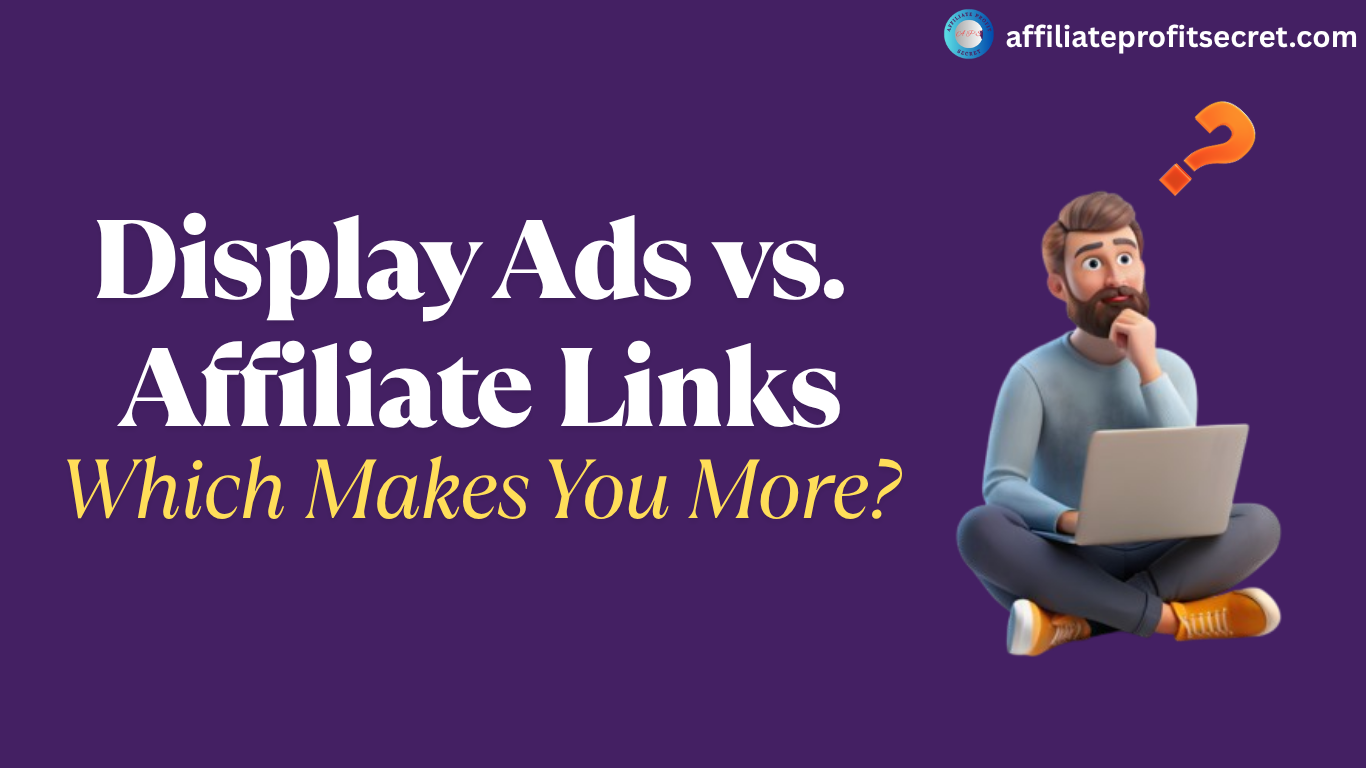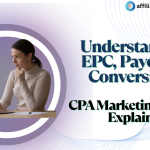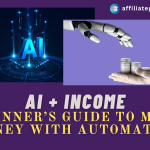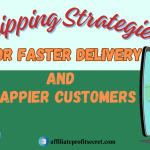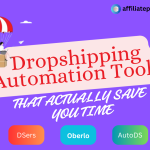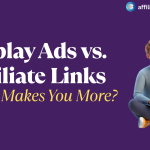Welcome to my article on “Display Ads vs. Affiliate Links: Which Makes You More?”. So, you’ve built a blog, sprinkled in some keywords, published a few posts, and now you’re ready to cash in. But wait—should you slap on some display ads and start earning pennies per click, or dive into affiliate marketing and hope someone buys that standing desk you reviewed six months ago? Ah yes, the eternal question: Display ads vs. affiliate links—who makes it rain harder? The truth is, both monetization methods can work, but they don’t operate the same way—and they definitely don’t pay the same. Display ads are the “set it and (kind of) forget it” option. They earn you money every time someone visits your site and doesn’t immediately click away. Meanwhile, affiliate links are more like a persuasive best friend—you only earn when your content convinces someone to buy, sign up, or take action.
This post breaks down the pros, cons, and cold, hard earning potential of both models. Whether you’re running a food blog that gets thousands of visits a day or a niche site with just a few readers (but high purchase intent), we’ll help you figure out which income stream suits your blog—and your goals—best. Spoiler: sometimes it’s not about choosing one over the other… but about knowing when and how to use both without turning your blog into a blinking banner farm. Let’s dig into the details—and maybe, just maybe, help you make a little more money while you’re at it. 🤑
My Best Recommended & Proven Way to Make $100-$300 Daily – Watch This FREE Video to START >>>

How Each Model Works (So You’re Not Guessing)
Let’s be honest—“make money blogging” sounds like one of those vague internet promises sandwiched between miracle diets and ads for magic wrinkle creams. But unlike those, this one’s real. You can earn real income from your blog—but only if you understand how the money actually flows in.
Let’s break down the two most common monetization models—display ads and affiliate links—without making your brain melt.
Display Ads: The Digital Real Estate Approach
Display ads are like subletting little corners of your blog to advertisers. Platforms like Google AdSense, Mediavine, and Ezoic place banner ads, sidebar widgets, and sometimes those sneaky in-content units that show up just as your reader hits a good part. You get paid based on impressions (views) and/or clicks—depending on the ad network.
The payout? Usually calculated in CPM (cost per thousand impressions). So, if a network pays $10 CPM and you get 10,000 pageviews a month, that’s around $100. Not life-changing, but hey—passive income is passive income. Plus, there’s no need to sell anything, pitch products, or do mental gymnastics trying to sound “genuinely excited” about yet another VPN.
The catch? It’s a volume game. Unless you’ve got serious traffic, display ads are more about slow drips than big splashes.
Affiliate Links: The Recommendation Engine
Affiliate marketing is more performance-based. You promote a product or service you genuinely like (hopefully), your reader clicks the unique affiliate link, and if they make a purchase (or sign up, depending on the offer), you get paid. Think of it as being the friendly internet tour guide who says, “Trust me, this one’s worth your time.”
Networks like Amazon Associates, ShareASale, and Impact are full of offers, and some bloggers earn thousands a month this way—especially in niches where readers have buying intent (tech, finance, home office gear, etc.).
It’s higher effort: you need persuasive content, audience trust, and ideally some proof that you know what you’re talking about. But it’s also higher reward. One good review or tutorial with the right affiliate links can outperform 100,000 ad impressions.
TL;DR:
- Ads = pennies per view, but easy to scale with traffic.
- Affiliate links = commissions per action, more work but more earning power per visitor.
Now that you know how the gears turn, let’s dive into what really matters—which one pays more (and under what circumstances). Spoiler: it’s not a one-size-fits-all answer… but it is a fun comparison. Let’s go. 🤑
Show Me the Money: Which One Pays More?
Alright, let’s talk dollars—because that’s why you’re here, right? (No shame. Blogging is fun, but getting paid to do it is chef’s kiss.) So which model—display ads or affiliate links—actually brings in the bigger bucks?
Short answer? Affiliate links can pay way more per visitor.
Longer answer? It depends. (Yeah, we know… but hang in there.)
Let’s Talk Numbers
With display ads, income is mostly tied to traffic volume. The metric you’ll hear tossed around is RPM (Revenue Per Mille = earnings per 1,000 views).
Here’s what that usually looks like:
- Low-end ad networks (Google AdSense): $2–$5 RPM
- Higher-tier networks (Mediavine, AdThrive): $10–$30+ RPM (depending on niche, location, etc.)
So if you’re getting 50,000 monthly pageviews and you’re on a solid network paying $20 RPM, you’re looking at around $1,000/month. Not bad for passive income that scales with traffic.
Now, affiliate marketing? That’s more of a quality-over-quantity game. You could earn $0 if no one clicks or buys—or you could earn $100+ from a single post if the stars (and readers’ wallets) align. Some niches (tech, finance, SaaS) offer $50–$200 commissions per sale. Even Amazon, with its lower percentages, can add up quickly if you’re moving physical products.
My Best Recommended & Proven Way to Make $100-$300 Daily – Watch This FREE Video to START >>>
So, with just 5,000 visitors a month, a well-optimized affiliate blog could outperform a display-ad blog with 50,000+ views. It’s all about intent: are your readers just browsing… or buying?
Real-Life Example Time
- Recipe blog: Gets 100,000 monthly views but mostly casual readers = great for ads.
- Tech tutorial blog: Gets 10,000 views from people searching “best mic for podcasting” = affiliate gold mine.
So… Which Pays More?
If you’ve got high traffic and chill content, ads are the way to go.
If you’ve got lower traffic but strong buyer intent, affiliate links can make it rain.
Pros & Cons of Each Monetization Method
Okay, now that we’ve peeked into both wallets, let’s break down the strengths and weaknesses of each monetization model—because no method is perfect (kind of like that one friend who’s super fun but always 40 minutes late).
🟩 Display Ads: The Set-It-and-(Mostly)-Forget-It Option
✅ Pros:
- Passive income: Once set up, you earn just by getting eyeballs on your site. No selling, no persuading, no 4-paragraph product reviews.
- Monetizes all traffic: Even if visitors just skim and bounce, you still make money.
- Easy to implement: Most ad networks provide plug-and-play code, and some even optimize placements for you.
- Consistent earnings: As long as your traffic stays steady, so does your income. It’s the tortoise in the tortoise-and-hare race.
❌ Cons:
- Low RPM (Revenue per Mille): You’ll need significant traffic to make anything more than “treat-yourself coffee” money.
- Can slow down your site: Ads can bloat your page load speed and turn your blog into a sluggish scroll-fest.
- User experience suffers: Nothing screams “I’m trying to pay rent” like a pop-up ad about toenail fungus in the middle of your gluten-free muffin recipe.
- Limited control: You can block categories, but sometimes weird, irrelevant ads still sneak through.
🟦 Affiliate Links: The High-Risk, High-Reward Hustle
✅ Pros:
- Higher potential earnings: One affiliate sale can be worth 1000 ad impressions (sometimes literally).
- Better suited to niche content: Especially where readers are already looking to buy—like product reviews, tutorials, or “best of” lists.
- Flexible and scalable: You can promote products, services, digital tools—whatever fits your audience.
- Builds trust and authority: If done right, you become a go-to source for recommendations (hello, expert status).
❌ Cons:
- No clicks = no cash: If your content doesn’t convert, your earnings stay at zero.
- More effort required: You need to research, write persuasively, build trust, and avoid sounding like a walking infomercial.
- Can feel “salesy”: Push too hard and you risk losing reader trust. Push too little and they don’t click at all.
- Payout delays and cookie windows: Sometimes commissions take weeks to show up, and links expire faster than your motivation on a Monday morning.
My Best Recommended & Proven Way to Make $100-$300 Daily – Watch This FREE Video to START >>>
🎯 Final Thought:
Both methods can absolutely work—but they play very different games. Think of ads as your steady, quiet roommate who pays rent on time, and affiliate marketing as your freelancer friend—unpredictable but capable of landing a huge contract out of nowhere.
Still unsure which is right for your blog? Up next, we’ll help you decide which model best fits your niche, content style, and goals. Let’s go! 👇
Which Is Right for Your Blog? (And Can You Use Both?)
By now, you’re probably thinking, “Okay, I get how ads and affiliate links work—but which one is actually right for my blog?” Great question. Let’s figure that out before you accidentally turn your homepage into a virtual garage sale.
The truth is, there’s no one-size-fits-all answer. Choosing between display ads and affiliate links depends on a few key things:
➡️ Your niche
➡️ Your traffic levels
➡️ Your readers’ intent
➡️ And your personal tolerance for tweaking, testing, and staring at analytics at 2 a.m.
💡 When Display Ads Make Sense
- You have steady, high traffic (think 25,000+ sessions/month).
- Your content is more informational than commercial (e.g., recipes, parenting tips, general lifestyle posts).
- You want passive income that grows as your traffic does.
- You don’t want to write about blenders unless you really care about blenders.
If your audience is just browsing for info, not shopping for tools, services, or software, ads help you monetize without forcing a hard sell.
💡 When Affiliate Links Are a Better Fit
- You create product-based or tutorial content (e.g., reviews, comparisons, “how to use X” guides).
- Your readers are actively searching for solutions (and maybe even ready to buy).
- You enjoy recommending stuff and building trust with your audience.
- You’re okay with putting in a bit more effort for a much higher payout per click.
Affiliate marketing works best when your readers are primed to take action—whether that’s buying a tool, signing up for a course, or trying that coffee subscription you’re always raving about.
⚖️ Can You Use Both? Absolutely.
Here’s the secret most successful bloggers won’t shut up about: you can—and should—use both (strategically). A well-balanced blog might use display ads to earn from every visitor, while affiliate links are baked into high-intent content like reviews or tutorials.
Just remember: don’t force it. If your post is a heartfelt story about parenting struggles, maybe don’t shove five affiliate links for air fryers in there. Let the content dictate the monetization—not the other way around.
Final Tip:
Start with the method that fits your current traffic, content, and comfort level—then experiment. Blogging income isn’t a light switch; it’s more like a dimmer dial. You’ll find the right mix by testing, tweaking, and, yes, occasionally failing upward.
Ready for the wrap-up? Let’s pull it all together in a nice, monetized little bow. 🎁👇
Conclusion: Choose Strategy, Not Just Tools
At the end of the day, making money from your blog isn’t about picking the “right” monetization tool—it’s about using the right strategy for your audience, your content, and your goals. Display ads and affiliate links aren’t enemies; they’re just different flavors of blog income. One’s slow and steady, the other’s more high-stakes and high-reward. Both can work beautifully—or flop miserably—if applied without intention.
My Best Recommended & Proven Way to Make $100-$300 Daily – Watch This FREE Video to START >>>
Instead of blindly slapping ads on every post or dropping affiliate links like breadcrumbs, take a step back. Ask: What does my reader need here? What’s their intent? Then serve that need—with helpful content, trust-building recommendations, or an ad that doesn’t scream, “I gave up on UX.”
And remember: you can test, pivot, and combine methods as your blog grows. Blogging is part art, part science, and part “let’s see what happens.”
So don’t just monetize. Monetize strategically. Your readers (and your bank account) will thank you.
Thanks a lot for reading my article on “Display Ads vs. Affiliate Links: Which Makes You More?″ till the end. Hope you’ve helped. See you with another article.
